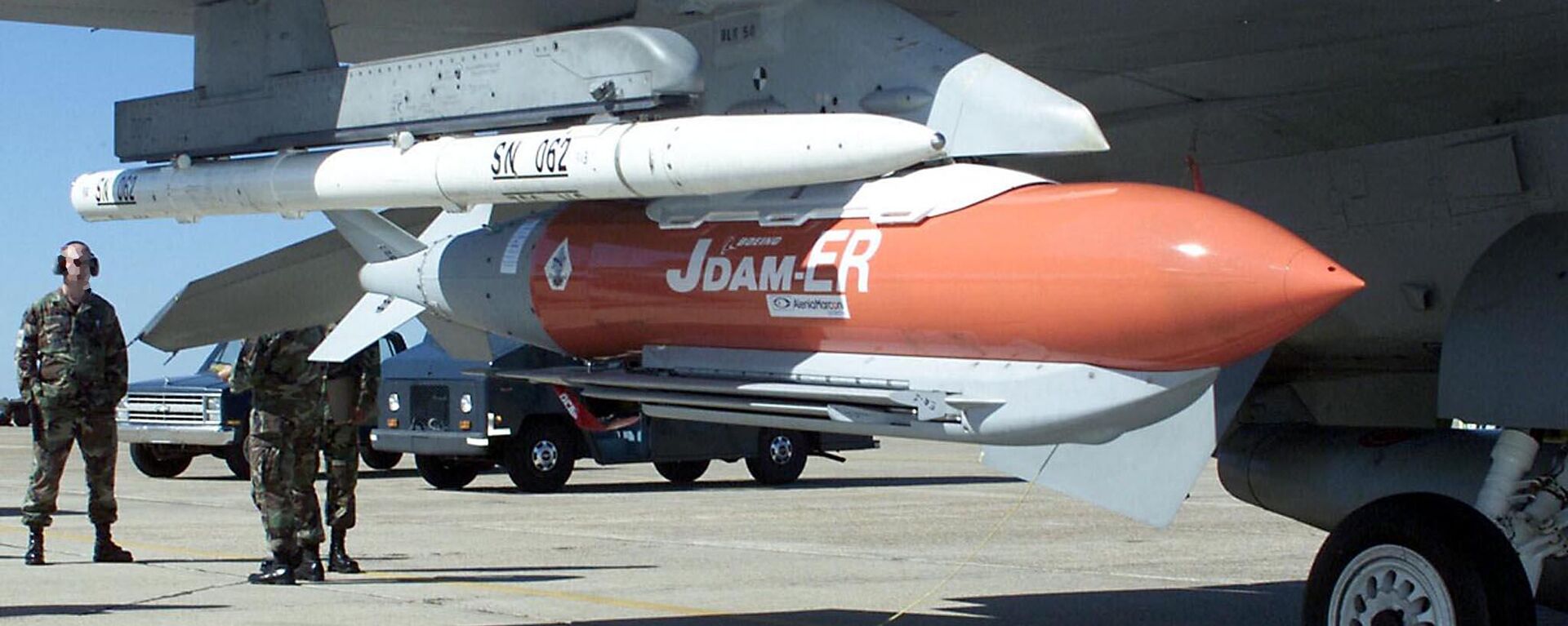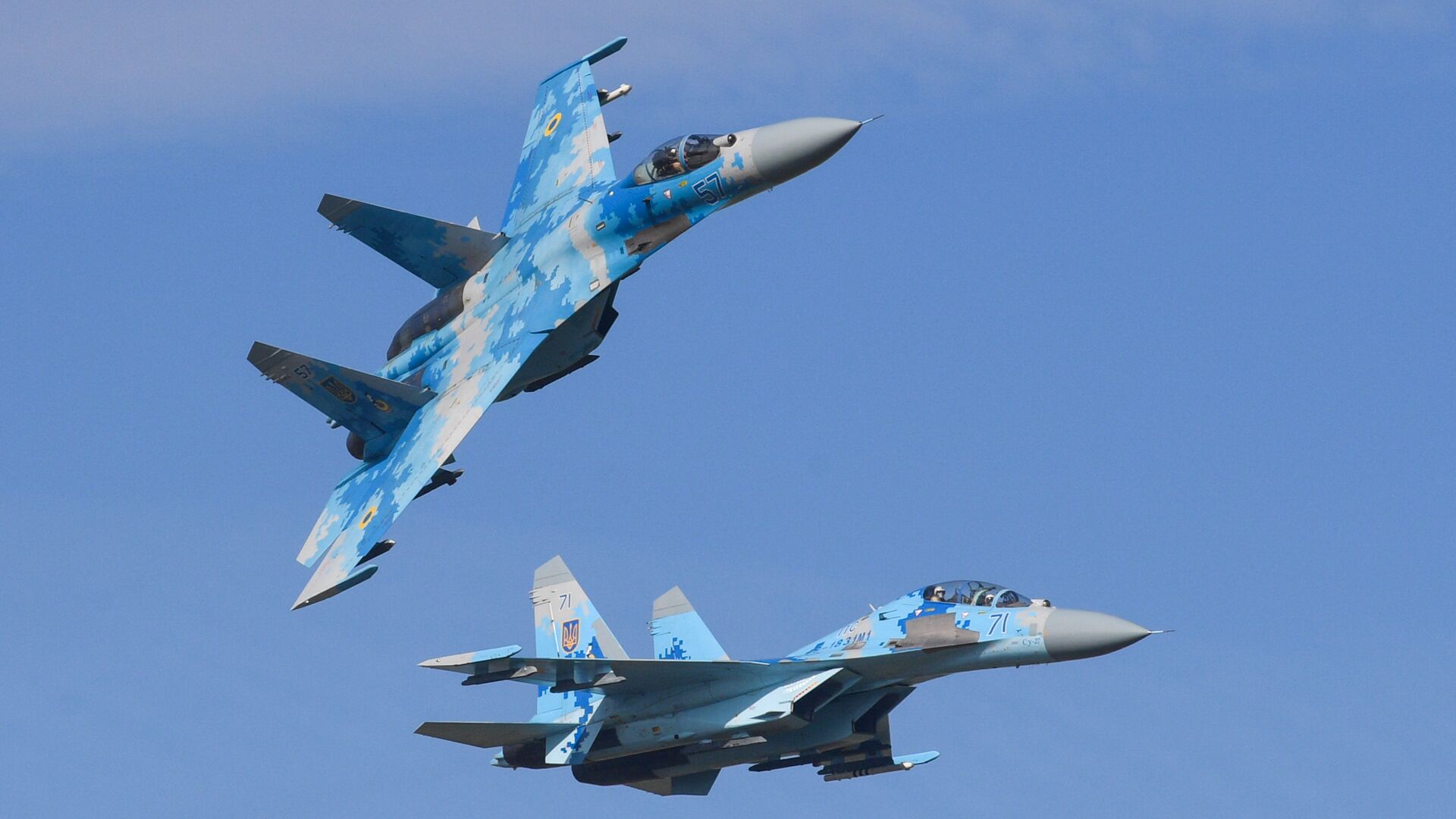https://sputnikglobe.com/20230825/what-are-jdam-er-smart-bomb-kits-us-is-sending-ukraine-and-how-can-russia-dumb-them-down-1112892667.html
What are JDAM-ER Smart Bomb Kits US is Sending Ukraine, and How Can Russia Dumb Them Down?
What are JDAM-ER Smart Bomb Kits US is Sending Ukraine, and How Can Russia Dumb Them Down?
Sputnik International
The Ukrainian Air Force’s top brass has confirmed Kiev’s possession and use of US-provided Joint Direct Attack Munition-Extended Range (JDAM-ER) smart glide... 25.08.2023, Sputnik International
2023-08-25T16:03+0000
2023-08-25T16:03+0000
2023-08-25T16:33+0000
military
ukraine
russia
ukrainian air force
su-27
sukhoi
joint direct attack munition (jdam)
https://cdn1.img.sputnikglobe.com/img/106893/68/1068936872_0:187:2650:1678_1920x0_80_0_0_2eafbb1c7dc79aefb8f32ca1c2d824cd.jpg
The Ukrainian Air Force showed off a JDAM-ER glide bomb kit on Thursday, with the military branch’s X account posting a photo of Air Force Commander Mykola Oleshchuk signing a JDAM-ER-equipped bomb attached to a customized hard point under the wing of a Sukhoi Su-27 fighter. Oleshchuk’s celebratory message of “Death to Moskals, for Ukraine,” (Moskal is a derisive term used by Ukrainian nationalists to refer to Russians) coincided with the 32nd anniversary of Ukraine’s Independence Day festivities.What are JDAM-ERs, Why are They ‘Smart,’ and Where Have They Been Used Before?JDAM-ERs are a Boeing-manufactured bomb kit designed to convert "dumb bombs" (i.e. unguided, free-fall air-dropped munitions) into "smart bombs," that is, precision munitions equipped with fins and some type of guidance system to enable them to travel longer ranges and accurately hit ground targets.In the case of the JDAM-ER, the all-weather bomb kit comes with GPS guidance, and is designed to accommodate bombs with a payload of up to 2,000 pounds (over 900 kg). US-standard Mark 82 bombs souped-up JDAM-ER kits can reach a range of up 70 km+, and feature a target deviation of as little as 11 meters, when launched from compatible US aircraft. Their capabilities when fired from Ukraine’s Soviet-made jets are unknown, but thought to be lower (with a range of 40-50 km, and a 50-meter target deviation, according to Russian military observer Yuri Knutov).Before they were sent to Ukraine, JDAMs of various modifications were heavily deployed by the US in Afghanistan and Iraq, and during NATO’s bombings of Yugoslavia (1999) and Libya (2011). The kits have also been exported and used by Saudi Arabia, Turkiye, Pakistan, and the Philippines against militias and insurgencies.How Did Ukraine Adapt Its Planes to Fire JDAM-ERS?US business media first reported on Washington’s plans to send JDAM-ERs to Ukraine in February as part of a $1.85 billion arms aid package announced by the White House in December.Ukraine officially confirmed its possession of JDAM-ERs in late March, with Ukrainian forces reportedly dropping four 500-pound JDAMs on a high rise apartment building in Artemovsk (Bakhmut) in April in an apparent bid to stop Russian forces, who ultimately liberated the city in May.With US help, the Ukrainian Air Force adapted its JDAM-ERs to Su-27s, as well as Mikoyan MiG-29s, and possibly Sukhoi Su-24s. The Pentagon provided custom hard point kits fitted with digital data buses to make them compatible with Ukraine’s Soviet-era aircraft. The data bus provides the bomb with information about its location and speed while being dropped, with ground crews programming target coordinates into the bomb manually before the mission begins.What are the JDAM-ERs' Weaknesses and How Can Russia Defeat Them?The biggest problem with the bombs is that for them to be used effectively, the Ukrainian aircraft carrying them need to approach to within range of Russian air defenses before dropping them. If they approach to within 20-140 km of their targets, they risk being downed by Russia’s medium-range air defenses, including Pantsir, Tor, and Buk missile systems.At longer ranges, enemy jets can be targeted by S-300 and S-400 missile systems, which operate at standoff ranges (i.e. distances well beyond the range of the missiles carried by enemy planes) of between 75 and 400 km.The latter capabilities put nearly all Ukrainian airspace east of the Dnepr River within range of Russian air defenses, and make the operations of military aircraft and helicopters highly dangerous, if the Russian MoD’s data on Ukrainian losses is anything to go by. On Friday alone, Russian forces reported shooting down two Ukrainian Su-25 jets over the Kherson and Donetsk regions, while a Russian representative in Zaporozhye said that Ukrainian forces had lost a fighter jet during fighting for the strategic Zaporozhye town of Rabotino.Another problem is the JDAM-ER kits’ dependence on GPS guidance. In May, US media reported that the Russian military’s sophisticated electronic warfare equipment can jam the JDAMs’ guidance systems and cause them to go off course and miss their targets. A US official confirmed that the Pentagon has been “advising” Ukraine’s forces to try to identify and destroy Russian jammers to prevent them from doing their job defeating JDAMs and other advanced US-made systems, including HIMARS rocket artillery.Russia's anti-aircraft missile and jamming capabilities demonstrate in practice a point that US-based journalist and political analyst Caleb Maupin observed in a conversation with Sputnik last month: that while the US and its allies have been able to use their militaries to effect in conflicts against countries with limited or non-existent air defenses like Iraq, Libya, and Yugoslavia, their capabilities weaken dramatically when forced to fight an actual peer adversary like Russia, something the proxy war in Ukraine has amply demonstrated.How is Ukraine Using Its JDAM-ERs?Knutov told Sputnik that it’s difficult to predict where exactly Ukraine will attempt to deploy its JDAM-ERs.
https://sputnikglobe.com/20230222/us-plans-to-give-kiev-long-range-gps-guided-bombs-once-used-to-devastate-iraq-afghanistan-reports-1107701239.html
https://sputnikglobe.com/20230716/failed-proxy-war-with-russia-shows-us-cant-pick-on-someone-its-own-size-1111920103.html
ukraine
russia
Sputnik International
feedback@sputniknews.com
+74956456601
MIA „Rosiya Segodnya“
2023
News
en_EN
Sputnik International
feedback@sputniknews.com
+74956456601
MIA „Rosiya Segodnya“
Sputnik International
feedback@sputniknews.com
+74956456601
MIA „Rosiya Segodnya“
ukraine, russia, jdam, jdam-er, dumb bomb, smart bomb, kit, long-range, heavy bomb, munition
ukraine, russia, jdam, jdam-er, dumb bomb, smart bomb, kit, long-range, heavy bomb, munition
What are JDAM-ER Smart Bomb Kits US is Sending Ukraine, and How Can Russia Dumb Them Down?
16:03 GMT 25.08.2023 (Updated: 16:33 GMT 25.08.2023) The Ukrainian Air Force’s top brass has confirmed Kiev’s possession and use of US-provided Joint Direct Attack Munition-Extended Range (JDAM-ER) smart glide bomb kits. What’s the purpose of these weapons? What are their capabilities? And what tools does the Russian military have at its disposal to stop them? Sputnik explains.
The Ukrainian Air Force showed off a JDAM-ER glide bomb kit on Thursday, with the military branch’s X account posting a photo of Air Force Commander Mykola Oleshchuk signing a JDAM-ER-equipped bomb attached to a customized hard point under the wing of a Sukhoi Su-27 fighter. Oleshchuk’s celebratory message of “Death to Moskals, for Ukraine,” (Moskal is a derisive term used by Ukrainian nationalists to refer to Russians) coincided with the 32nd anniversary of Ukraine’s Independence Day festivities.
What are JDAM-ERs, Why are They ‘Smart,’ and Where Have They Been Used Before?
JDAM-ERs are a Boeing-manufactured bomb kit designed to convert "dumb bombs" (i.e. unguided, free-fall air-dropped munitions) into "smart bombs," that is, precision munitions equipped with fins and some type of guidance system to enable them to travel longer ranges and accurately hit ground targets.
In the case of the JDAM-ER, the all-weather bomb kit comes with GPS guidance, and is designed to accommodate bombs with a payload of up to 2,000 pounds (over 900 kg). US-standard Mark 82 bombs souped-up JDAM-ER kits can reach a range of up 70 km+, and feature a target deviation of as little as 11 meters, when launched from compatible US aircraft. Their capabilities when fired from Ukraine’s Soviet-made jets are unknown, but thought to be lower (with a range of 40-50 km, and a 50-meter target deviation, according to Russian military observer Yuri Knutov).
Before they were sent to Ukraine, JDAMs of various modifications were heavily deployed by the US in Afghanistan and Iraq, and during NATO’s bombings of Yugoslavia (1999) and Libya (2011). The kits have also been exported and used by Saudi Arabia, Turkiye, Pakistan, and the Philippines against militias and insurgencies.

22 February 2023, 12:31 GMT
How Did Ukraine Adapt Its Planes to Fire JDAM-ERS?
US business media
first reported on Washington’s plans to send JDAM-ERs to Ukraine in February as part of a $1.85 billion arms aid package announced by the White House in December.
Ukraine officially confirmed its possession of JDAM-ERs in late March, with Ukrainian forces reportedly dropping four 500-pound JDAMs on a high rise apartment building in Artemovsk (Bakhmut) in April in an apparent bid to stop Russian forces, who ultimately liberated the city in May.
With US help, the Ukrainian Air Force
adapted its JDAM-ERs to
Su-27s, as well as Mikoyan
MiG-29s, and possibly Sukhoi
Su-24s. The Pentagon provided custom hard point kits fitted with digital data buses to make them compatible with Ukraine’s Soviet-era aircraft. The data bus provides the bomb with information about its location and speed while being dropped, with ground crews programming target coordinates into the bomb manually before the mission begins.
What are the JDAM-ERs' Weaknesses and How Can Russia Defeat Them?
The biggest problem with the bombs is that for them to be used effectively, the Ukrainian aircraft carrying them need to approach to within range of Russian air defenses before dropping them. If they approach to within 20-140 km of their targets, they risk being downed by Russia’s medium-range air defenses, including Pantsir, Tor, and Buk missile systems.
At longer ranges, enemy jets can be targeted by S-300 and S-400 missile systems, which operate at standoff ranges (i.e. distances well beyond the range of the missiles carried by enemy planes) of between 75 and 400 km.
The latter capabilities put nearly all Ukrainian airspace east of the Dnepr River within range of Russian air defenses, and make the operations of military aircraft and helicopters highly dangerous, if the Russian MoD’s
data on Ukrainian losses is anything to go by. On Friday alone, Russian forces reported shooting down two Ukrainian Su-25 jets over the Kherson and Donetsk regions, while a Russian representative in Zaporozhye said that Ukrainian forces had lost a fighter jet during fighting for the strategic Zaporozhye town of Rabotino.
Another problem is the JDAM-ER kits’ dependence on GPS guidance. In May, US media
reported that the
Russian military’s sophisticated electronic warfare equipment can jam the JDAMs’ guidance systems and cause them to go off course and miss their targets. A US official confirmed that the Pentagon has been “advising” Ukraine’s forces to try to identify and destroy Russian jammers to prevent them from doing their job defeating JDAMs and other advanced US-made systems, including HIMARS rocket artillery.
Russia's anti-aircraft missile and jamming capabilities demonstrate in practice a point that US-based journalist and political analyst Caleb Maupin observed in a
conversation with Sputnik last month: that while the US and its allies have been able to use their militaries to effect in conflicts against countries with limited or non-existent air defenses like Iraq, Libya, and Yugoslavia, their capabilities weaken dramatically when forced to fight an actual peer adversary like Russia, something the proxy war in Ukraine has amply demonstrated.
How is Ukraine Using Its JDAM-ERs?
Knutov told Sputnik that it’s difficult to predict where exactly Ukraine will attempt to deploy its JDAM-ERs.
“From time to time, Ukrainian aviation operates in the south Donetsk direction and in the Zaporozhye direction, including using similar bombs. An especially large attack was launched by Ukrainian forces in the Zaporozhye direction using various bombs, Storm Shadow cruise missiles, JDAMs and HIMARS rockets. Moreover, they used these expensive, high-precision munitions specifically against trenches. Not specific targets, but against trenches held by our servicemen. This speaks to the Ukrainian Army’s desire to advance, even if just a little bit, at any cost, and to then declare to the whole world that Ukrainian forces managed to win at least some significant victory,” in its flagging counteroffensive, the observer said.







